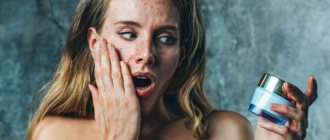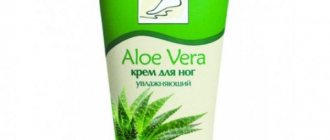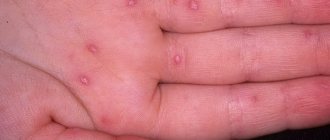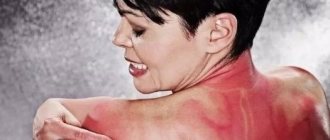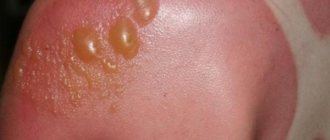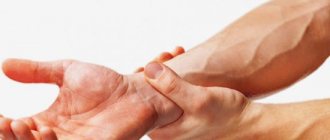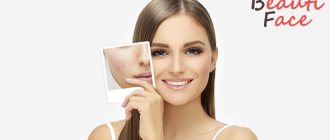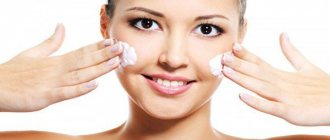Mechanism of reaction
People who are prone to allergies perceive absolutely safe substances as antigens.
When they enter the body, an increased amount of IgE begins to be released. Once an allergen is identified, this immunoglobulin binds to basophils and mast cells.
The complex, including basophils, can enter the nose, lungs, digestive tract, and skin.
At the same time, mast cells, penetrating into organs, remain immobile.
When the allergen enters the body again, these cells will release histamine.
It is a special chemical substance aimed at eliminating the allergen.
Histamine provokes capillary dilation, smooth muscle spasms, swelling and blood thickening. As a result, the body reacts to the presence of an allergen in the blood.
Why do formations appear?
A blistering rash on the body and arms is called urticaria. It can occur under the influence of various factors. Often its formation is caused by chronic diseases of organs and systems:
But since blisters on the body and hands are allergic manifestations, a common cause of their occurrence is various disorders in the body when exposed to an irritant:
Skin irritation occurs when a person comes into direct contact with an allergen, as well as during prolonged exposure to the irritant. Various substances can influence the occurrence of this type of allergy. Skin rashes are formed under the influence of:
Often an allergy in the form of blisters is observed in a child. This is due to the fact that the child’s body is more susceptible to the influence of irritants. In this case, atopy develops in childhood. The risk group includes children who have a genetic predisposition to such manifestations. If mom or dad has an allergy, the child may also have one.
Types of allergies and their symptoms
There are many varieties of the disease that have characteristic symptoms.
Respiratory
This allergy appears as a reaction of the body to house dust, strong odors and pollen.
The manifestations of this disease affect exclusively the respiratory system.
Pathology develops as a result of exposure to external and internal allergens; in more rare cases, it is provoked by infectious factors.
The severity of symptoms is influenced by the sensitivity of the respiratory system and the depth of exposure to the allergen.
The clinical picture of the respiratory form of the disease includes the development of:
- rhinitis;
- tracheitis;
- rhinosinusitis;
- laryngitis.
Chronic exposure to an allergen can lead to bronchial asthma.
To make a correct diagnosis, the doctor must study the clinical picture of the disease in detail and analyze the family history.
Identification of provoking factors is of no small importance.
Contact
This type of allergic reaction occurs as a result of direct skin contact with food or household chemicals.
Manifests itself in the form of development:
- atopic dermatitis;
- dermatosis;
- hives.
Characteristic symptoms of the contact form of pathology are:
- redness;
- itching sensation;
- swelling;
- blisters on the skin.
Food
This is the most common type of allergy - according to statistics, about 90% of people react to eating certain foods.
Most often, problems are caused by foods such as citrus fruits, eggs, and sweets.
Food allergies manifest themselves as:
- hives;
- eczema;
- neurodermatitis or Quincke's edema.
Sometimes more serious disorders are observed - these may be changes in the blood or problems in the digestive system.
To identify the disease and identify the allergen, it is recommended to conduct skin tests, keep food diaries, and perform provocative tests that provoke an immune response upon contact with certain allergens.
Photo: Eczema
Insect
This type of disease manifests itself as the body's reaction to insect bites.
Also, a provoking factor may be the penetration of their metabolic products into the respiratory system.
The reaction to the stings of bees, hornets or wasps is characterized by a deterioration in the general condition. A person may experience weakness, dizziness, drop in blood pressure...
How to treat a rash?
Before starting treatment, you must consult a doctor. An allergist or dermatologist will examine the affected skin surfaces on the hands and body, and will also prescribe tests to identify the allergen. Once the irritant is detected, contact with it must be eliminated. In this case, the hives will begin to subside. In this case, the reaction will have significantly fewer consequences. After this, medications are prescribed to relieve allergic manifestations.
In some cases, it may be necessary to open the blisters. After the procedure, it is necessary to treat the wound with antiseptics and anti-inflammatory drugs:
This will avoid suppuration of the wound. Irritation and itching are relieved with the help of Anestezin, Menthol, Diphenhydramine, as well as citric, acetic and carbolic acids. If the rash does not itch, the body will be protected from the penetration of pathogenic microorganisms. It is important to reconsider your own diet. Should be excluded:
- consumption of salt and foods high in salt (to remove fluid and prevent swelling);
The condition of a person’s skin can provide a lot of information about health and allows one to suspect the development of pathological processes. The signs of exposure to allergens of various natures on the body are especially pronounced. The patient may experience redness, peeling, pigmentation, and pimples. Skin allergies in the form of blisters are an immune response to a potentially harmful substance. This type of rash is called urticaria. It is accompanied by significant itching of the affected areas, burning and depression of health.
Recent Entries
The body's allergic reaction can manifest itself in different ways. For some types of allergies (food), the main symptoms of immune system rejection will be gastrointestinal disorders, for others (respiratory, contact), in most cases, symptoms such as breathing problems, rhinitis, excessive lacrimation, and urticaria are characteristic.
Blisters on the skin appear with different types of allergies.
They arise as a result of the body’s skin reaction to the presence of a foreign body – an allergen.
Allergy blisters can appear on different parts of the body - arms, back, stomach, legs, elbows and wrists. As a rule, they form in groups. Sometimes their appearance can only be detected when the damaged area of skin begins to itch and itch.
Blisters on the skin occur with hives, a symptom of an allergic reaction that affects the skin.
Blisters on the body form in the following cases of allergies:
- on pets;
- chemical substances;
- plant pollen;
- Sun rays;
- cold;
- Food;
- house dust;
- medications.
Blisters on the body appear quite quickly and disappear after a few hours.
Blisters on the skin are dangerous because vigorous scratching can lead to the spread of lesions to other areas of the body.
To avoid further growth of areas where blisters are located, it is necessary to take antihistamines, which can alleviate the condition of allergies.
Blisters on the surface of the skin, filled with fluid or pus, appear upon contact with an allergen. Immune cells located on the skin thus react to the invasion of a foreign body (allergen) and begin to fight it.
Contact with an allergen, in which bubbles with liquid appear on the body, can be either external or internal. The occurrence of such neoplasms is a type of skin reaction to an allergy.
In addition to the appearance of bubbles with liquid, as well as deterioration of the skin, other symptoms of an allergic reaction may include:
- general weakness;
- dizziness;
- a sore throat;
- soreness;
- runny nose;
- conjunctivitis;
- temperature increase;
- problems with the gastrointestinal tract (vomiting, constipation, diarrhea);
- difficulty breathing;
- drop in blood pressure.
During an allergic reaction, hands are most often exposed to skin rashes in the form of water blisters.
The localization of the affected areas varies - from the fingertips to the forearms.
A characteristic feature of such formations is that they begin to burn, itch and itch.
It is not advisable to scratch them, otherwise you can get infected, and the source of water blisters will spread to other parts of the body. When the rashes begin to dry out, a crust forms in their place, which disappears over time without a trace.
Water blisters on the hands form upon contact with different types of allergens. Among them:
- food (products containing allergens);
- airborne (plant pollen, house dust, animal hair);
- industrial (chemical and toxic substances found in household chemicals);
- medicinal (certain types of medications, for example, antibiotics).
With proper treatment (taking antihistamines, no contact with the allergen, maintaining personal hygiene, etc.), water blisters on the hands will completely disappear a few days after their appearance.
Even without delving into the intricacies of medical science, you can understand that our skin...
Treatment
It is necessary to eliminate contact with the allergen. Drug therapy is usually used.
Medicines
Your doctor may recommend:
- Antihistamines. They block histamine synthesis and reduce swelling of the affected area. Such drugs include Erius, Claritin, Diazolin, Tavegil, Suprastin, Diphenhydramine, Fenkarol. Children require drops of Fenistil, Zodak, Parlazin, Zyrtec, and Erius syrup.
- Glucocorticoids. These are hormonal drugs that are prescribed to reduce the intensity of inflammation and quickly eliminate blisters on the body. These are Dexamethasone, Kenalog, Triamcinolone.
- Antipruritics. Salicylic acid, products with menthol, calendula, citric and carbolic acid help effectively. Fenistil-gel, Gistan, Beloderm, Lorinden, etc. may be prescribed...
- Calcium products – calcium gluconate, calcium chloride. They reduce the permeability of vessel walls, which slows down the formation of exudate (the contents of bubbles).
- If a skin allergy occurs due to the consumption of food products or medications, enterosorbents are needed to help remove allergens. These are activated carbon, Enterosgel, Polyphepan, for children - Smecta.
- Vitamins A, C, E, which strengthen the walls of blood vessels.
- Sedatives if the cause of the disease is serious stress.
Physiotherapeutic methods
PUVA therapy and UVA irradiation are used. Do not apply if the disease occurs due to exposure to the sun. They may recommend therapeutic baths and wet wraps.
Opening the bubbles
If the blister is very large, your doctor may order it to be opened. To prevent the formation of an abscess, antiseptic agents are used - a solution of potassium permanganate and anti-inflammatory agents with tannin and ichthyol.
Diet
During the illness it is recommended:
- transition to plant foods;
- exclusion from the menu of smoked meats, eggs, fast food, soda, sweets, citrus fruits, strawberries, canned food, spices;
- limiting the amount of salt to reduce swelling;
- Dishes prepared by frying are removed from the diet;
- You need to drink alkaline mineral water more often, for example, Borjomi.
Hygiene
The affected areas should be periodically washed with warm water and hypoallergenic soap or soap with birch tar. It is forbidden to rub the skin with a washcloth and dry with hard towels. Do not apply cosmetics. Application of vegetable oils is allowed.
Folk remedies
They help effectively, but you need to get a doctor’s permission to use them, otherwise an exacerbation of the disease is possible.
Options:
- Soak a cloth in cold milk and apply it to the blistered skin for 15 minutes.
- Brew 20 g of dried nettle with a glass of boiling water. You need to make lotions with the cooled and strained infusion. Effectively relieve itching. Baths with the addition of infusions of nettle, sage, St. John's wort, chamomile, and celandine are recommended.
- Grind the celery root in a meat grinder and squeeze the juice out of the pulp. Take 1 tsp. twice a day shortly before meals.
- 3 tsp. mint is brewed with a glass of boiling water. You need to leave for an hour and drink 50 ml three times a day.
- Brew and drink like regular tea. The tincture should have a golden hue. If it becomes cloudy, you should not drink the liquid. Not recommended for children under three years of age and pregnant women.
- Cut raw potatoes into plastic pieces or grind them into pulp and apply to the affected areas.
- 1 tsp. Stir soda in a glass of warm water and make lotions.
- Take magnesium three times a day on the tip of a knife.
The mechanism of skin allergies
An allergic rash on a person’s skin can appear due to various dermatological diseases that can be a consequence of an allergic reaction. This is due to the excessive sensitivity of the skin to external and internal irritants. These irritants often include medications, foods, fabrics, pollen, pet dander, and more.
Why does the reaction occur?
Allergies on the surface of the hands in the form of blistering formations appear when various diseases occur. All of them are allergic in nature. Often a skin rash occurs with atopy. In this case, the allergy is due to a hereditary predisposition. In this case, the person may suffer from:
On the skin of the hands, lesions can occur when these areas come into direct contact with an irritating substance. In this case, a contact allergy is noted. Sometimes an allergen systemically affects the body from the outside or from the inside. In this case, a reaction in the form of bubbles on the hands appears under the influence of:
Lesions on the skin can occur under the influence of various factors. Therefore, treatment will be carried out depending on the nature of the influence.
Blisters on the hands are a consequence of contact with an allergen.
Causes of skin allergies in adults
There are a large number of allergens that can trigger an unwanted skin reaction.
This, in turn, is the cause of the development of allergic dermatosis.
Many experts believe that the number of allergy sufferers has begun to increase rapidly due to unfavorable changes in the environmental situation and due to the consumption of genetically modified products.
In addition, various cosmetics contain haptens, which can also trigger skin allergies.
Skin rashes can be caused by the following allergens:
- Household dust.
- Chemistry.
- Cosmetics.
- Clothes made from synthetic fabrics.
- Medications.
- Food.
- Personal hygiene products.
- Pet fur.
- Pollen.
Allergy prevention
To prevent red spots and blisters from forming, you must follow simple rules.
- Maintain personal hygiene.
- Workout.
- Eliminate stressful situations.
- Remove contact with the irritant. If this is not possible, for example, due to work, then use protective equipment when working with allergens.
- To refuse from bad habits.
Any disease can occur due to human fault. These are, for example, constant stress, consumption of low-quality foods, a sedentary lifestyle, and neglect of personal hygiene.
If you don’t want hives to form, you need to watch your lifestyle. For any manifestations, you should consult a specialist who will help you cope with your allergies.
Allergy is an immune reaction in response to repeated exposure to an allergen. Pathology has external manifestations. Rashes, itching, burning, redness and other signs of the disease occur on the epidermis.
If an allergy occurs, blisters may appear on the skin. Such rashes are called urticaria. Blisters are accompanied by discomfort.
Pathology requires timely qualified treatment. Any independent therapeutic measures lead to undesirable consequences.
The mechanism of skin allergies
The main factor in the manifestation of allergic dermatosis is considered to be an allergen - a substance of molecular structure that is of protein origin.
It happens that allergens can be various elements that do not provoke an immune response when they penetrate the blood.
Particles that are carried by antigenic determinants are called haptens. These elements can bind to tissue proteins. Haptens are found in medications and other chemicals.
If an allergen or irritant enters the human body, sensitization begins to develop, which subsequently leads to excessive sensitivity of histamine receptors. This action is explained by the formation of antibodies or the synthesis of sensitized leukocytes.
An allergic rash on the skin of an adult forms at the stage of pathophysiological development of the disease.
At this time, mediators of the pathological process are able to affect normal skin cells, provoking an inflammatory process.
Itching
In most cases, skin allergies can be accompanied by itching of varying intensity. The main causes of itching are external and internal allergens.
The body begins to perceive such allergens as dangerous, which results in an allergic reaction in the form of itching. There are several main allergic skin diseases that can be accompanied by itching.
These diseases are described below.
Here you will find in more detail the answer to the question of what to do when a spot on the skin itches due to an allergy.
How to cope with the disease?
How to treat such skin changes? It is best to visit a specialist who, having examined all the signs and learned about possible allergens, will prescribe the optimal and effective treatment.
- Remove contact with the allergen both while taking medications and in the future. This will not only help reduce the risk of developing dangerous symptoms, but also make it easier to treat the patient.
- Antihistamines are designed to reduce the level of histamine influence on the patient's body. They help reduce swelling of the affected areas of the skin. There are drugs that act on the entire body or on a specific place. The most recommended are: tavegil, peritol, claritin. These medications must be prescribed by a doctor.
- Glucocorticoids are hormonal drugs used to stabilize cell membranes. They help reduce the spread of the inflammatory process and reduce the signs of allergies. These medications are triamcinolone, kenalog, dexamethasone.
- Calcium-containing preparations help reduce the permeability of the vascular wall. This prevents the formation of exudate (the substance that fills the blisters). These include calcium gluconate and calcium chloride.
- Vitamins help reduce the permeability of vascular walls. It is recommended to use as an additional remedy in the fight against the disease. Vitamins C, A, E are useful.
- Enterosorbents. If a food product is found to be an allergen, then the use of enterosorbents helps remove toxins from the body. This can be regular activated carbon, polyphepan or enterosgel.
All of the medications listed should be taken only after consulting a doctor. Self-medication is dangerous to human life.
Removing fluid
The doctor may recommend opening the blister. We must not forget to use an antiseptic (boric acid, potassium permanganate) and anti-inflammatory (ichthyol, tannin) agent. This will help prevent suppuration of the wound, reduce the separation of exudate and the inflammatory process.
If the blisters on your skin are itchy
When dealing with blisters, it is necessary to use products that help cope with the itching. These are menthol, anesthesin, citric, carbolic, acetic acid. They not only promote rapid healing of rashes, but also help prevent the risk of purulent formations.
You should also worry about changing your dietary habits.
- It is necessary to reduce the intake of salt, which retains water, contributing to swelling.
- Remove quickly digestible carbohydrates from your diet.
- Remove fried foods from your diet. Gradually eliminate eggs, sweets, soda, smoked foods, and citrus fruits.
- Adhere to more vegetarian habits.
Do not use washcloths or sponges on affected areas of the skin. You should wash only with hypoallergenic soap. Do not use cosmetic cream or lotion. To moisturize, you can use Vaseline or vegetable oil.
Allergic rashes in adults
It is also worth noting that allergies can simply be expressed by rashes on the skin without the presence of itching.
However, an allergic rash may look different, depending on the disease itself.
Features of an allergic rash:
- The rashes do not have a clear shape.
- The spots have blurred edges.
- The color of the spots can range from pink to dark red.
- The rash may be accompanied by mild swelling.
- Sometimes peeling appears.
- The rashes can be localized throughout the body, depending on the type of allergy.
- Rashes can take various forms: spots, nodules, blisters, blisters.
Skin problems
During the off-season, people's lives are often complicated by skin problems. Red spots on the body cause trouble as a cosmetic flaw and cause serious inconvenience to the owner:
- start to itch
- there is a painful sensation,
- peeling of the skin is detected,
- the skin becomes wet.
There are many reasons for the occurrence of infirmity, ranging from allergic manifestations to problems, for example, the gastrointestinal tract. We need to calmly figure it out and find the reasons that cause such phenomena.
Red spots that look like burns bother people. The first prerequisite appears as obvious - a case of urticaria. But the circumstance is alarming if the areas of redness do not itch. This means that a personal examination by a dermatologist and, at the same time, passing tests are necessary. This measure will protect a person from various contraindications.
When the red rash does not itch or hurt, it is assumed that there are abnormalities in the autonomic nervous and vascular systems. Practice shows that emotional overload or stress is accompanied by a red rash and the appearance of spots.
The phenomenon is explained by the fact that the tone of the nervous system is disturbed, and as a result, small-vascular dilation is observed in certain places of the skin. As the person calms down, the spots go away and disappear.
A lack or excess of certain types of vitamins in the body, imbalances in nutrition, and pathologies in the functioning of internal organs are reflected on the skin.
Skin rashes on the arm and leg
In the most unforeseen situations, a red spot similar to a burn may appear on the hand. Periodically, it becomes crusty and cracks until it bleeds. After washing, the scab becomes soaked and a red swelling remains on the hand. Then everything is repeated all over again, a crust grows again, which sometimes itches.
In such situations, experts recommend making a scraping to detect a fungal disease and performing a biopsy. It may be necessary to make differential diagnoses.
Similar specks that do not cause discomfort, sometimes lightening or darkening, may appear on the leg. When they appear, you should think about coin-shaped eczema.
Sometimes in such cases, Elidel cream helps, which is spread on the affected area twice a day for 3 weeks. The fact is that this cream is not a hormonal product. But it is still better and safer to start treatment only after a doctor has prescribed medications.
What causes red spots on the neck
It happens that the cause of skin spots is hidden in yeast-like lichens. This pathogen is called pityriasis fungus, which has chosen the upper layer of the skin as its place of reproduction.
The yeast-like pathogen disrupts the activity of cells called melanocytes, where the dark pigment melanin is synthesized. The consequence of such an invasion is a picture where a red spot appears on the neck.
Under certain factors, skin lesions become brighter and more noticeable. This is facilitated by:
- high body temperature;
- heavy physical loads;
- skin impurities;
- increased sweat secretion.
Unfortunately, such blots appear on different parts of the body, including on the thigh, which do not hurt or itch. They don’t get wet, they don’t swell, but they don’t disappear either. This disaster results from contact with marine life.
Algae or jellyfish, inhabitants of the sea, not wanting to harm a person, with one touch to the skin leave a mark and memory of themselves for a long time. The option to get rid of the disease would be a thorough medical examination of the skin of the entire body.
Skin lesions in children
Parents are especially concerned about spots that appear on their child’s face. At the same time, the baby’s well-being changes; the reasons for the deterioration in his mood are not immediately clear to parents.
And these inexplicable spots require urgent treatment. Therefore, you need to talk to your doctor and find out the reasons in order to prevent further development of the disease.
The appearance of spots signals a serious problem in the child’s health. When diagnosing, it is specified what the baby was fed, when the rash was discovered, and how the child behaves. Based on a detailed explanation from the parents, it is easier for a specialist to establish a diagnosis and prescribe effective treatment.
Diagnosis of skin diseases
Diagnosing dermatological diseases is difficult, because the nature of the rash has similar manifestations, although their nature is different:
- infectious origin;
- allergic reaction;
- oncological signs.
For any changes in the skin, you need to seek help from dermatologists. There are many reasons that cause neoplasms on the skin, similar to a burn.
The body responds in a unique way to:
- use of certain medications;
- alcoholic drinks;
- poor quality food products;
- chemicals;
- lack of vitamins;
- bacteria, microorganisms.
